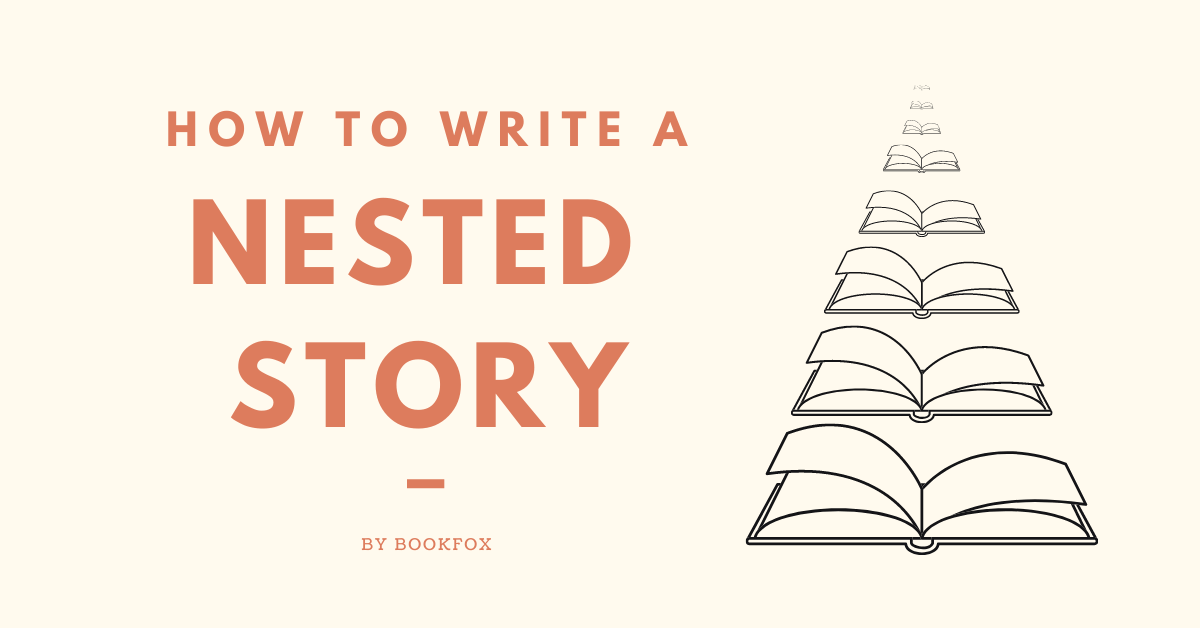 A key part of writing a novel is figuring out the structure of your story. However, this structure might actually only be one layer of your novel.
A key part of writing a novel is figuring out the structure of your story. However, this structure might actually only be one layer of your novel.
Complex plots often contain multiple layers of story.
A shorter story contained inside a longer story or novel is called a story-within-a-story, an embedded story, or a nested story. The outside story which introduces or surrounds the shorter story is called a frame story.
Imagine you are looking at a painting on the wall of a museum. As you take in the scene depicted on the framed canvas, you notice a framed picture on the wall within the painting. You step closer. There is another entire scene inside that smaller frame.
A nested story creates this effect on the page.
Sometimes a nested story and its frame story together called matryoshka stories. This is because their interlocking structure resembles a set of Russian nesting dolls. Natasha Lyonne’s Netflix series Russian Doll is named for its use of this plotting method.

The story-within-a-story concept was around a long time before Netflix. Authors have come up with many different ways to include stories-within-stories. You can use these strategies to create interesting, multi-layered novels.
1. Have Your Character Write a Story
 One way to include a story within your story is to have your character write the inside story. This engages the reader by making them feel included in the active writing process.
One way to include a story within your story is to have your character write the inside story. This engages the reader by making them feel included in the active writing process.
Andrew Altschul’s novel The Gringa is narrated by Andres, an American expat writer living in Peru. Andres lands a gig writing a magazine article about Leonara Gelb, an infamous American college-student-turned-leftist-terrorist.
As he gets deeper into his research, Andres starts to write a story reconstructing—and imagining—Leonora’s clandestine life. This narrative soon balloons far beyond the limits of the assigned magazine piece.
- Outside story: Andres’ first person narrative about his own life and work.
- Inside story: the story he is writing about Leonora.
In the outside story, Andres discusses the challenges of writing the inside story. At one point, he vents to a journalist friend:
“‘I don’t know what to do,’ I said. She watched me, waiting. ‘I don’t think I can write it. But I have to write it.’ I’d come that far, I said, spent months thinking of nothing else, but I still didn’t understand. ‘How do you do it. All these stories…death, torture, everyone killing everyone. How can anyone…’ I shook my head at my own childishness. ‘I just wanted to do something that matters.’
Andres’ openness about his research and writing process helps keep the reader engaged in the novel. They want to find out if Andres will be able to write the story he is struggling with. Just as importantly, they want to see how he does it.
Enter the Digital Age
 Strategies involving a physical manuscript might sound outdated if you are writing a contemporary novel set in the 2021. Most of the writing we do these days is online. Very few of us get our news from a newsstand like the one in Watchmen.
Strategies involving a physical manuscript might sound outdated if you are writing a contemporary novel set in the 2021. Most of the writing we do these days is online. Very few of us get our news from a newsstand like the one in Watchmen.
Don’t worry: Your manuscript-within-a-manuscript doesn’t need to be a physical object A digital manuscript will work too.
Jeanette Winterson uses digital nested stories in her internet novel, The PowerBook. Clients hire the novel’s narrator, Ali, to write fantasy stories for them through email. The novel alternates between Ali’s outside narration and her nested email manuscripts.
Different forms offer different narrative opportunities. Emails are, by their nature, written in second person. This form allows Ali to address her reader directly:
“The story is reading you now, line by line.
Do you know what happens next?
Go on, open it.
Open it….”
Of course, at the same time that Ali is addressing the fictional reader of her email stories, Winterson is also addressing the real-life reader of her novel. She takes the opportunity to make sure her reader keeps turning the page.
Emails are just one of the many options for digital manuscripts. Any of the following can work as a virtual manuscript-with-your manuscript:
- Text files saved on a hidden flash drive
- LiveJournal entries
- Substack newsletters
- Twitter threads
- Recorded podcasts
- Text-based Twine games
2. Set Up Oral Narration
 Spoken first-person narration is the most direct and personal form of storytelling. We have all sat down with a friend or relative and listened as they told us a story about their life.
Spoken first-person narration is the most direct and personal form of storytelling. We have all sat down with a friend or relative and listened as they told us a story about their life.
A frame story can be used to introduce introduce oral narration into your novel. This works a lot like using a frame narrative to introduce a nested manuscript.
If the narrator of your frame story is hearing the story in-person, the reader will feel as if they are hearing the story in-person themself. This is.a great way to build an intimate rapport with your reader.
Introduce Your Storyteller
Thomas Berger uses oral narration in his Western novel, Little Big Man. The novel’s frame story is written by a historian named Ralph Fielding Snell. In 1953, Snell meets an elderly man named Jack Crabb, who claims to be a 111-year-old survivor of the Battle of Little Bighorn (aka the Battle of the Greasy Grass, or Custer’s Last Stand).
Snell visits Crabb in his nursing home and records audio tape of Crabb’s winding account of decades of rough living on the frontier. These recordings of Crabb’s oral storytelling form the book’s nested first-person narration. Snell explains the conceit to the reader:
“As to the text: it is faithful to Mr. Crabb’s narration as transcribed literally from the tapes. I have subtracted nothing, and added only the necessary marks of punctuation: when the latter sometimes seem sparse, my motive has been to indicate the breathless rush in which these passages emerged from the speaker.”
After this introduction, the reader is prepared for Crabb’s colorful voice:
“My Pa had been a minister of the gospel in Evansville, Indiana. He didn’t have a regular church but managed to talk some saloonkeeper into letting him use his place of a Sunday morning for services.”
Crabb is a funny, fascinating, and unreliable. All of this makes him a great narrator for the book’s over-the-top plot. Still, his idiosyncratic oral narration would be a bad way to start a book. The reader wouldn’t understand why they were encountering such blunt, colloquial language. Snell’s frame paves the way for Crabb’s narration.
Downside: You have to sustain the spoken voice.
Usually, you only have to authentically capture a character’s spoken voice for a few lines of dialogue. That’s because, in most situations, dialogue and interior thoughts can be given in summary.
However, this is not the case if a character is orally narrating your novel. You will have to consider the character’s speech and phrasing for every line of the novel’s inside story.
3. Tell Micro-Stories In Dialogue
 Story-telling is a natural part of conversation. For this reason, passages of dialogue provide opportunities to nest a quick story. Best of all, this approach doesn’t slow down the overall plot.
Story-telling is a natural part of conversation. For this reason, passages of dialogue provide opportunities to nest a quick story. Best of all, this approach doesn’t slow down the overall plot.
Whenever a character speaks a line of direct dialogue, they temporarily take over as narrator. As a new narrator, they can tell a new story. You can even give minor secondary characters the opportunity to narrate a short, nested story.
Barry Gifford uses this technique throughout the novels of his Sailor and Lula series.
Two elderly women named Lula and Beany embark on a road trip to New Orleans in the series’ seventh book, Imagination of the Heart. In one scene, Lula’s son Pace tells a story about a mutual acquaintance over beers at a bar:
“‘Koomang told me he smuggled himself out of North Korea buried under a heap of stinking fish guts used as chum on a shark trawler. Made it across the Yellow Sea to Quingdao, China, then walked a thousand miles to Shanghai. He presented himself at the US consulate there and offered information about the North Korean nut job leader and the North Korean military in return for a visa to the United States. Two years later he settled in New Orleans.’
‘Heck of a story,’ said Beany.
‘Blessed be he that fleeth from the fear,’ said Lula.
‘Amen,’ said Pace, holding up his glass.”
Gifford takes the opportunity of a chatty bar scene to have one secondary character tell a biographical story about another secondary character. Because the dialogue is situated within a scene on Lula and Bean’s journey, the nest story fits logically within the novel’s broader plot.
Keep In-Dialogue Stories Short
Gifford’s technique relies on maintaining the outside scene. This only works if you keep the inside stories short.
Pace recounts Koomang’s biography in four sentences. As you can see, this is plenty of space to provide a satisfying story.
It is also short enough that it doesn’t break up the rhythm of the barroom dialogue. After Pace’s story, Beanie and Lula are able to quickly and seamlessly reenter the scene with their responses. The reader has not forgotten about them.
If your storyteller goes on for too long, your reader will lose track of the dialogue. Worse, the authority and continuity of your main narrative voice can be lost. For these reasons, you should keep in-dialogue stories very short (in proportion to the length of the entire scene).
4. Tell Micro-Stories within First Person Narration
 First-Person narration gives the reader the greatest access to your main character’s interior thoughts. You can use this access to embed a quick story within your character’s inner-monologue.
First-Person narration gives the reader the greatest access to your main character’s interior thoughts. You can use this access to embed a quick story within your character’s inner-monologue.
The narrator of Gillian Flynn’s thriller novel Sharp Objects is a newspaper reporter named Camille Preaker. She investigates a series of murders in her hometown. After a conversation with her editor, Camille recounts the stories that more prestigious newspapers are covering:
“More importantly, there was a serial killer stalking a more glamorous city, Seattle. Amid the fog and coffeehouses, someone was carving up pregnant women, opening their bellies, and arranging the contents in shocking tableaux for his own amusement.”
While this seems like a digression into an unrelated murder mystery, this nested news story actually helps define Camille’s own story in a number of ways:
- Characterization. As a self-proclaimed “second-rate journalist,” Camille is on top of current events, but views other stories as more important than the ones she covers.
- Setting. Camille’s description of Seattle as “more glamorous” hammers home the backwoods setting of Wind Gap, Missouri.
- Plot and Tension. The depiction of the gruesome violence committed by the Seattle serial killer reminds the reader of the stakes in the hunt for the Missouri serial killer.
The types of stories you can fit into your narrator’s inner-monologue will depend on the genre of your novel. Because Sharp Objects is a murder mystery, Flynn can only really afford embedded stories which relate to the novel’s violent themes. Otherwise, she would risk going too far off-topic and undermining the book’s constant sinister tone.
Take Advantage of Stream-of-Consciousness Narration
 In a stream-of-consciousness novel, on the other hand, there is much more leeway. For example, much of Teju Cole’s novel Open City consists of the narrator, Julius, wandering around New York City (it’s more exciting than it sounds).
In a stream-of-consciousness novel, on the other hand, there is much more leeway. For example, much of Teju Cole’s novel Open City consists of the narrator, Julius, wandering around New York City (it’s more exciting than it sounds).
In one scene, a glimpse of a disabled man on the subway prompts Julius to tell a traditional West African story:
“I got the idea that some of the things I was seeing around me were under the aegis of Obatala, the demiurge charged by Olodumare with the formation of humans from clay. Obatala did well at the task until he started drinking. As he drank more and more, he became inebriated, and began to fashion damaged human beings. The Yoruba believe that in this drunken state he made dwarfs, cripples, people missing limbs, and those burdened with debilitating illness. Olodumare had to reclaim the role that he had delegated and finish the creation of humankind himself and, as a result, people who suffer from physical infirmities identify themselves as worshippers of Obatala.”
Within the same chapter, Julius describes three other nested stories:
- The contents of a history book he buys
- The plot of a movie he watches in a theatre
- Part of a J.M. Coetzee book he has previously read
This mode of narration is expansive enough to include whatever passes through Julius’s mind. Because the reader has accepted that they are following Julius’ train of thought wherever it leads, the transitional phrase “I got the idea…” is enough to make the leap from observed reality to a religious tale.
Avoid This Mistake: Don’t Lose Track of Your Setting
If your narrator is completely lost in their thoughts, you run the risk of losing your reader. You can prevent this by grounding the narrator in physical space as they wander mentally.
Although Flynn’s narrator’s thoughts fly to Seattle, she remains rooted in the immediate work of reporting her story in Missouri. Likewise, even when Julius’s thoughts are a continent and centuries away, the reader knows that Julius is sitting on a train in Manhattan.
Make sure the reader is clear where the narrator is relating their nested story.
5. Put a Manuscript Inside Your Manuscript
 The most hands-on way to include a story-within-a-story is to have your main character find and read a book. In this scenario, the nested story is an actual object in your outside story.
The most hands-on way to include a story-within-a-story is to have your main character find and read a book. In this scenario, the nested story is an actual object in your outside story.
Alan Moore’s graphic novel Watchmen contains sections of a pirate comic, Tales of the Black Freighter. A news vendor who sells Black Freighter is a recurring static character in Watchmen. His sidekick, a local teenager, is often seen reading an issue of the comic.
As the Black Freighter comic book is physically present in the outside story, readers are not confused when they encounter pages of this inside story cut into Watchmen.
There are a couple ways to place a manuscript in your manuscript:
A. Introduce an Entire Manuscript
 The nested manuscript might actually be the main story you want to tell. In this case, the outside story is just a frame to introduce the nested manuscript.
The nested manuscript might actually be the main story you want to tell. In this case, the outside story is just a frame to introduce the nested manuscript.
John Gardner uses this technique in his novel Freddy’s Book. The first chapter of the book is narrated by Professor Winesap, who travels to Chicago for a conference. While there, he encounters a friend’s reclusive son, Freddy. Winesap learns that Freddy has been writing a book.
After Winesap gains his trust, Freddy gives Winesap his manuscript:
“He lowered the object and dropped it on the floor. It struck the carpet with a thud. Slowly, he drew back his hand. After that he rose, stood motionless a moment, then, without a sound, drew the door shut. I heard floorboards creak. He seemed to move more lightly now, as if had been a great weight he’d carried, that gift he’d brought, the object lying there solemn in the moonlight, mysteriously still and sufficient on the dusty gray carpet—Freddy’s book.”
The rest of Gardner’s novel is Freddy’s book, a medieval fantasy narrative about a Swedish knight named Lars-Goren. The physical handover of the manuscript creates a straightforward transition into its pages.
Since unusual story concepts often need a bit of explanation or context, you can use a frame narrative to sell the concept to the reader.
Readers who might have a harder time suspending disbelief around medieval fantasy narratives are already deep into Gardner’s novel before they set out on Lars-Goren’s supernatural quest. If you are worried that your story might not be accessible enough to readers, you should consider adding a an introductory frame narrative.
B. Weave in Sections of Manuscript
- Outside story: scholars in 1980s Britain who uncover a secret romance two 19th century poets.
- Inside story: the historical romance between these two poets
Byatt weaves writing by the long-dead poets throughout her book. Their flowery language—full of phrases like “golden-skinned in the gloom”—contrasts with the more-contemporary third person narration of the outside story.
Downside: Two Manuscripts is Twice the Work
You need your reader to believe that the nested manuscript is written by a different author than your outside story. For this to work, you need to write the two manuscripts in very different styles.
This requires a significant amount of work:
- You need to use a different Point of View. Even if both manuscripts are written in the third-person, they need to be different types of third-person narration. Otherwise, the manuscripts will bleed together.
- You should vary sentence length, vocabulary, imagery, and anything else that is characteristic of your outside story’s voice.
- The nested manuscript has to be older than your outside story. It can’t be written after it’s discovered (unless you are using time travel, which is a whole other topic!). If the manuscript is very old, you may need to use an older style of language. This is similar to writing historical fiction.
In short, you have to develop an entire second book, in addition to the book you are already writing. This might be a fun way to mix things up—or an extra challenge.
Remember: The narrator of the outside story is aware of the contents of the nested manuscript. The opposite is not true.
6. Draw Connections to Older Stories
 When you write about a character, you are making the claim that the character’s experiences are significant. You want the reader to feel that what happens to your character is important and meaningful.
When you write about a character, you are making the claim that the character’s experiences are significant. You want the reader to feel that what happens to your character is important and meaningful.
One way to highlight the importance of a character’s experience is to connect it to an older narrative.
Depending on the scope and content of your project, the older story could be from:
- Mythology
- Folk Tales
- Religious Parables
- World History
- Community History
For instance, in Jesmyn Ward’s Salvage the Bones, she’s constantly referencing Greek mythology through the story. Specifically, the story of Medea, who killed her two children as a way to get revenge on her husband Jason for cheating on her (and yes, this connects with the frame story).
Use Stories from Your Setting
 Leslie Marmon Silko’s novel Ceremony is about a Native American World War II veteran named Tayo, but Silko decided to include a story she’d grown up hearing on the Laguna Pueblo reservation:
Leslie Marmon Silko’s novel Ceremony is about a Native American World War II veteran named Tayo, but Silko decided to include a story she’d grown up hearing on the Laguna Pueblo reservation:
“I missed the people and the storytelling, so I incorporated into the novel the old-time story about Hummingbird and Green Fly, who help the people purify their town to bring back the Corn Mother.”
The inclusion of a traditional story in Silko’s novel does several things:
- Establishes the reservation setting.
- Places Silko’s novel within a Native American narrative tradition.
- Adds weight and meaning to Tayo’s story.
- Mixes things up, giving the reader a break from reading Tayo’s painful story.
- Creates a framework for the plot, as Tayo comes to understand he must embark on his own healing quest.
Silko doesn’t merely drop nested traditional stories into her novel as a flourish. Rather, they are central to her novel’s structure. She explains:
“I was conscious of constructing the novel out of many kinds of narratives or stories to celebrate storytelling with the spoken as well as the written word.”
Echo Your Outside Story
 In order for nested mythic and historical stories to be effective, you need to show clearly that they echo your outside story.
In order for nested mythic and historical stories to be effective, you need to show clearly that they echo your outside story.
The title story of Thom Jones’ collection The Pugilist at Rest is narrated by an severely-ill, middle-aged Vietnam War combat veteran and former boxer. Halfway through Pugilist, Jones’s narrator suddenly moves from a story about his life in the Marine Corp in the 1960s to a nested story about a 5th-century gladiator:
“Theogenes was the greatest of gladiators. He was a boxer who served under the patronage of a cruel nobleman, a prince who took great delight in bloody spectacles. […] It was the approximate time of Homer, the greatest poet who ever lived. Then, as now, violence, suffering, and the cheapness of life were the rule.”
A 2,500-year jump backward between paragraphs is a bold move. However, Jones does a few things to make sure that the parallels between the narrator’s life and Theogenes’ are clear:
- Earlier, the narrator has referred to himself as a “skilled boxer.” Identifying Theogenes as a “boxer” (not just a “gladiator”) connects the men through a shared vocation.
- In the paragraph right before the one introducing Theogenes, the narrator describes the gruesome deaths of his fellow Marines in battle. The mention of “bloody spectacles” soon after comments indirectly on this scene.
- The narrator states that the same essential rules of life applied “Then, as now.” This reinforces the connections between Theogenes’ time and the narrator’s time.
Talking about Theogenes allows the narrator to talk about his own traumatic history. The nested story reinforces and intensifies the outside story.
Earn the Reference
Simply dropping in a historical story would be awkward and jarring. You need to lay some groundwork first.
Jones’ narrator keeps his Vietnam War souvenirs in a sandalwood box. The contents of this box create a literal inventory of memories to explore in the story. The narrator mentions that he also has a picture of a classical statue:
“Perhaps it is Theogenes who is depicted in the famous Roman statue (based on the earlier Greek original) of ‘The Pugilist at Rest.’ I keep a grainy black-and-white photograph of it in my room.”
He then goes on to explain the statue in great detail. The image of the ancient boxer physically appears alongside the souvenirs from the narrator’s personal history. This shows that the story of Theogenes belongs alongside the man’s memories.
Throughout the story, the narrator also mentions reading various works of history, philosophy, and literature in the years since his military service. This provides characterization of the narrator. It also provides context for the Theogenes story. As someone who spends his time reading old books, it is plausible that the narrator would form connections between his own life and earlier generations of warriors.
It does not take a lot to establish a character’s access to historical or mythical stories. Once you’ve done that, you can bring these stories—and their power—into your story.
7. Experiment With Out-of-the-Box Structures
 Stories-within-stories are a great way to shake-up novel structures. In fact, there is no limit to how creative you can get with your structures.
Stories-within-stories are a great way to shake-up novel structures. In fact, there is no limit to how creative you can get with your structures.
Many writers have come up with unusual ways to layer stories:
- If on a winter’s night a traveler by Italo Calvino. The frame story of If on a winter’s night is in second person POV. The narrator is talking directly to you, the reader of Calvino’s book. In each chapter, you find yourself in a completely different book. Basically, this is the manuscript-within-a-manuscript technique times ten.
- Pale Fire by Vladimir Nabokov. The inside story of Pale Fire is a long, dense poem. The outside story is made up of detailed (well, convoluted) notes and commentary on the poem, written by an unhinged professor. This unreliable narrator claims to have been friends with the poet, but people continue to debate what’s really going on here.
- Breakfast of Champions by Kurt Vonnegut. This zany book is about a sci-fi writer named Kilgore Trout. Trout is referenced in other books by Vonnegut, and there is even a real-life sci-fi novel (Venus on the Half-Shell) attributed to him. Breakfast of Champions includes nested novels manuscripts by Trout. However, Vonnegut also adds another layer when he himself enters the outside story to comment on writing it.
Between the Pages
A more recent example of an out-of-the-box structure is S., a collaboration between the writer Doug Dorst and the film director J.J. Abrams. This work pushes limits of what a book even is.
On first glance, the entire book is a novel titled Ship of Theseus by V.M. Straka. However, Ship of Theseus is only the inside story. Another, outside, story about two students surrounds Straka’s novel. This story is told through marginal notes written on the text, as well as letters and other documents physically inserted between the novel’s pages.
Experiments like S. are interesting, as they force us out of our usual writing (and reading) habits.
If you have an out-of-the-box idea about how to layer stories in your project, go ahead and give it a try. Even if it doesn’t work out, the experiment will help you learn about novel structure.
Downside: Experimental projects are hard sells.
Getting any novel published is difficult enough these days. Considering this, it is unlikely that an acquiring editor will want to take on a project that alienates readers with the lack of a central, stable narrative voice.
Of course, the authors mentioned above all have their die-hard fans. You might find yours. There are some awesome small presses who are open to less conventional writing. You might find a good match, that is interested in taking on your experimental project.
Even then, however, it is unlikely a small press will have the budget for projects which require unusual printing or assembly. A publisher would probably not have taken on S. if Abrams was not already a successful TV producer. Likewise, Breakfast of Champions might not have found a readership if Vonnegut hadn’t already written more popular books like Cat’s Cradle.
Generally speaking, you are better off with a more subtle strategy (like those discussed above) that involves a central narrative frame, and seamlessly leads readers into nested stories through plot, narration, or dialogue.
Final Advice: Write Each Story Separately
 One of the reasons stories-within-stories are so effective is because of their kaleidoscope effect. As you read, new stories appear before your eyes. The inside and outside stories lock together in interesting and unexpected ways.
One of the reasons stories-within-stories are so effective is because of their kaleidoscope effect. As you read, new stories appear before your eyes. The inside and outside stories lock together in interesting and unexpected ways.
However, if you try to write nested stories straight through, the kaleidoscope effect works against you. Trying to shift between stories while you draft is very confusing. It is rarely effective to try to write in two different voices in one writing session.
The only way to avoid this is to write each story separately. This is true for every one of the approaches discussed in this article.
Treat the Inside Story as a Complete Story
Your nested story might only be one paragraph long. It might be included within a scene dialogue or first-person narration. Even so, it will be easier to write it first as a stand-alone short story.
Open and title a new document for every single story. Your novel “manuscript” might initially be dozens of different documents, before they are assembled into a full draft. That’s fine.
Programs like Scrivener make it particularly easy to manage multiple documents for one project. That being said, you can always maintain a folder of separate stories in Word, Google Drive, or whatever program you are most comfortable with. You can also keep a hard-copy notebook full of micro-stories to nest.
Treat the new story as you would any short story or flash fiction piece. Consider the story’s plot, narrative voice, and characters as you would for any independent story. If the story isn’t satisfying as a stand-alone story, it won’t be satisfying as a nested story.
Put the Pieces Together
When it comes time to place your pre-written nest stories inside your pre-written frame story, you can focus entirely on using the above strategies to integrate them together.
In Topeka by Ben Lerner, a middle-aged author writes a book about his younger self. Lerner weaves together the character’s contemporary first person frame narration, third person nested narration about his younger self, and first and third person sections about other characters.
When you read Lerner’s book, the sections seem as if they just fit together naturally, falling into place one after the other. Of course, this wasn’t the case in early drafts. Nothing about writing a book comes naturally. Good editing just makes it feel that way.
Lerner wrote the sections of his novel separately. He tried different arrangements, and worked to fine-tune the sections so they fit together:
“I had to get the order of the sections, because so much of the book is about how language circulates across voices, how one speaker’s speech shows up in another character, so I had to get the rhythm of that right across sections.”
This assembly and revision might take you as long as the actual writing process did. It will be worth it. Once you fit all the pieces together, you will be surprised how much the outside and inside stories strengthen each other.
Guest Author:
Ben Nadler is the author of the novel The Sea Beach Line. He is currently a Ph.D. candidate in English at SUNY Albany.


3 comments
Hi Ben:
I am almost finished writing such a nested novel. The experience is a brain-twister and great delight. Thank you for your insight. Please keep in touch.
I am working on an Early Reader for children and I have a separate story that I would like to weave in to the initial story. So I think this will help me, even though this may not have never been done in an early reader.
I appreciate this article. The information I s useful. In my case, the girl is telling a story to her brothers. Should I make the nested story in a different font, put it in quotes, or italics?